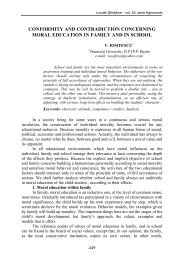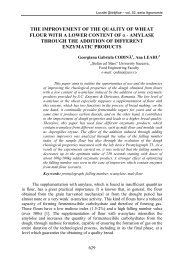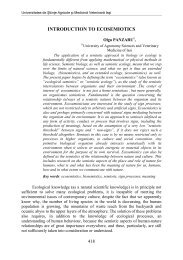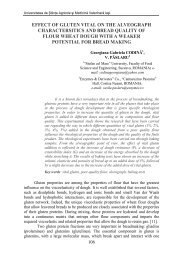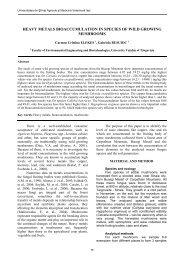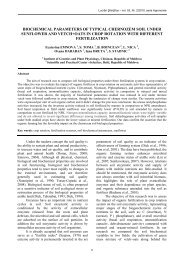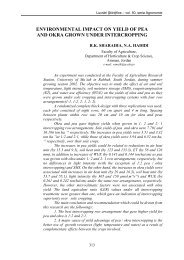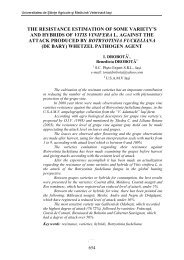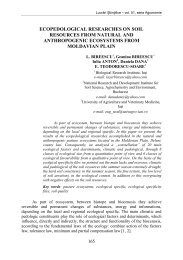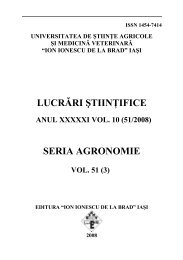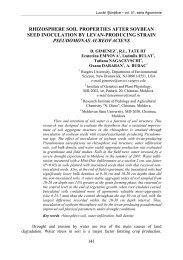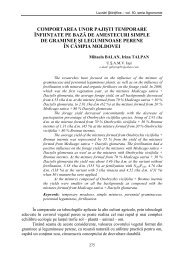morphogenetical aspects in helianthus annuus l. during the ...
morphogenetical aspects in helianthus annuus l. during the ...
morphogenetical aspects in helianthus annuus l. during the ...
Create successful ePaper yourself
Turn your PDF publications into a flip-book with our unique Google optimized e-Paper software.
Universitatea de Şti<strong>in</strong>ţe Agricole şi Medic<strong>in</strong>ă Veter<strong>in</strong>ară Iaşi<br />
MATERIAL AND METHOD<br />
Vegetal material <strong>in</strong>vestigated from histo-anatomic po<strong>in</strong>t of view was preserved<br />
from a cultivated field near Iasi city. It consists <strong>in</strong> whole plants, <strong>in</strong> different stages of<br />
ontogenesis. All plants were been fixed and preserved <strong>in</strong> ethylic alcohol 70%. The<br />
sections made with free hand us<strong>in</strong>g a razor blade and colored with ru<strong>the</strong>nium red and<br />
methylen-blue. At this species <strong>the</strong> anatomical longitud<strong>in</strong>al symmetry phenomenon was<br />
evidenced. The photos were made after <strong>the</strong> obta<strong>in</strong>ed permanent slides us<strong>in</strong>g an<br />
Olympus BX51 microscope with an Olympus E-330 digital photo camera.<br />
RESULTS AND DISCUSSIONS<br />
The root with primary structure is tetrarch with 4 strands of xylem and 4<br />
strands of phloem (fig. 1a). The secondary structure is generated from <strong>the</strong> vascular<br />
and cork cambium activity. The vascular cambium arises from a comb<strong>in</strong>ation of<br />
<strong>the</strong> procambium and pericycle cells. The cork cambium is formed entirely from<br />
pericycle cells (fig. 1b). Secretory canals occur on <strong>the</strong> <strong>in</strong>ner cortex and phloem, but<br />
<strong>the</strong>y may also occur <strong>in</strong>ternally to <strong>the</strong> endodermis, associated with <strong>the</strong> pericycle;<br />
<strong>the</strong>se situations have been recorded <strong>in</strong> two species of <strong>the</strong> tribe Helian<strong>the</strong>ae [6].<br />
The stem is circular <strong>in</strong> cross section at all analyzed levels (fig. 1c, 2a, c). The<br />
epidermis shows numerousness large non-glandular and glandular hairs (fig. 1c).<br />
Under <strong>the</strong> epidermis, 8-11 layers of angular collenchyma could be observed (fig.<br />
1d, e, 2b). The cells have visible thick walls at <strong>the</strong>ir corners; between cells,<br />
especially <strong>in</strong> <strong>the</strong> <strong>in</strong>ternal part, some <strong>in</strong>tercellular spaces are visible. The<br />
endodermis is s<strong>in</strong>uous, more visible near <strong>the</strong> vascular bundles; between bundles,<br />
isolate islands of phloemic tissue could be observed (fig. 1e, f).<br />
The stem with primary structure conta<strong>in</strong>s collateral type vascular bundles<br />
arranged cyclically. At <strong>the</strong> top of <strong>the</strong> stem, an undifferentiated mechanic tissue<br />
protects each bundle (fig. 1d). In <strong>the</strong> secondary structure, this tissue will become a<br />
sclerenchyma (fig. 2a, c). In <strong>the</strong> cortex and <strong>in</strong> <strong>the</strong> pith, secretory canals, with a tight<br />
or large lumen and 4-10 epi<strong>the</strong>lial cells could be observed (fig. 1c, d, 2c, d, e). The<br />
organization of secretory structures <strong>in</strong> Asteraceae has been extensively studied by<br />
Col (1904) [2]. He recognized two dist<strong>in</strong>ct types of secretory canals: <strong>the</strong> secretory<br />
canal itself, which is always formed near <strong>the</strong> endodermis, and secretory purses,<br />
which are wider and shorter than <strong>the</strong> canals, and have <strong>the</strong>ir cavity surrounded by<br />
secretory cells.<br />
The secondary structure is formed by only by cambium activity. It produces<br />
new vascular bundles, only with secondary structure, between <strong>the</strong> <strong>in</strong>itial one. At<br />
this level only <strong>the</strong> secondary phloem is functional (fig. 2f).<br />
The petiole is semicircular <strong>in</strong> cross section, with rounded angles. In<br />
hypodermic position angular collenchyma could be observed (fig. 3a).<br />
The midrib is visible prom<strong>in</strong>ent on <strong>the</strong> adaxial and abaxial sides, both <strong>in</strong> young and<br />
ma t u r e lea ves ( f i g. 3b , d ). T he you n g lea ves ar e cover ed wit h<br />
182<br />
182




